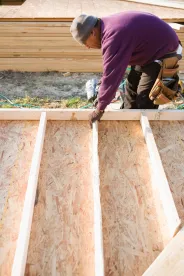Piecemeal appellate-court decisions have put developers and contractors in a catch-22 with respect to the timing of indemnification claims against their subcontractors. Their indemnification claims against subcontractors might be barred by the two-year statute of limitations unless they wait until after the underlying construction defects litigation is resolved in order to take advantage of the 90-day tolling period. But waiting until the underlying construction defects litigation is resolved might result in their indemnification claims being barred by the six-year statute of repose.
Colorado law, at Section 13-80-104(1)(a), C.R.S., provides a two-year statute of limitations and a six-year statute of repose for construction defects actions:
Notwithstanding any statutory provision to the contrary, all actions against any architect, contractor, builder or builder vendor, engineer, or inspector performing or furnishing the design, planning, supervision, inspection, construction, or observation of construction of any improvement to real property shall be brought within the [two-year limitations period] provided in section 13-80-102 after the claim for relief arises, and not thereafter, but in no case shall such an action be brought more than six years after the substantial completion of the improvement to the real property, except as provided in subsection (2) of this section.
However, Section 13-80-104(1)(b)(II), C.R.S., provides the following 90-day tolling provision for indemnification claims related to construction defects actions:
[A]ll claims, including, but not limited to indemnity or contribution, by a claimant against a person who is or may be liable to the claimant for all or part of the claimant’s liability to a third person . . . [a]rise at the time the third person’s claim against the claimant is settled or at the time final judgment is entered on the third person’s claim against the claimant, whichever comes first; and . . . [s]hall be brought within ninety days after the claims arise, and not thereafter.
This “tolling” provision is supposed to allow general contractors and developers to defend against construction-defects claims without having to bring third-party claims against every subcontractor and supplier. Instead, the general contractor can, within 90 days after judgment or settlement of the defects lawsuit, bring an indemnification action against the proper subcontractors responsible. As acknowledged by the Court of Appeals, “[t]he purpose of section 13-80-104(1)(b)(II) was to streamline construction defect litigation by . . . defer[ring] the running of the statute of limitations on indemnity and contribution claims that construction professionals who are defendants in construction defect lawsuits might have against another person.” Thermo Dev., Inc. v. Cent. Masonry Corp., 195 P.3d 1166, 1168 (Colo. App. 2008).
Based on these statutes, an October 20, 2016, decision by a division of the Colorado Court of Appeals created an odd situation where indemnification claims, if brought too early, can actually be barred by the statute of limitations. InSopris Lodging, LLC v. Schofield Excavation, Inc., 2016COA158, owner Sopris Lodging filed a construction defects action against general contractor TDC in 2013. In 2014, while the owner’s claims against it were pending, TDC filed third-party indemnification claims in the same action against several subcontractors, including Schofield Excavation. The claims all accrued in 2011. So the owner’s claims against TDC were timely filed in 2013. But TDC’s indemnification claims against Schofield Excavation filed in 2014 where technically untimely under the two-year statute of limitations.
Schofield Excavation filed a motion for summary judgment based on the statute of limitations. In response, TDC argued that the 90-day tolling provision in Section 13-80-104(1)(b)(II), C.R.S., applied to toll the statute of limitations on its indemnification claims. But the trial court and the Court of Appeals disagreed, and the Court of Appeals held that the tolling provision only applied in instances where the indemnification claims were brought after the underlying defects action was either settled or resolved by final judgment.
TDC did not wait to file claims against subcontractors in a separate lawsuit. Instead, it chose to assert third-party claims in the original construction defect litigation. Therefore, section 13-80-104(1)(b)(II) did not apply to TDC’s third-party claims. But had TDC waited until after Sopris Lodging’s underlying claims against it were resolved to file its indemnity or contribution claims against its subcontractors, then section 13-80-104(1)(b)(II) would have applied, and its indemnification claims would not have been time barred. Id. at ¶ 19. So TDC essentially brought its indemnification claims too late and too soon.
So under the Schofield Excavation opinion, section 13-80-104(1)(b)(II), C.R.S., basically can resurrect dead indemnification claims that otherwise would be barred by the statute of limitations. But there is a catch: The statute of repose may still apply.
In Sierra Pacific Industries, Inc. v. Jason Bradbury, d/b/a Bradbury Construction, Inc., 2016COA132, a division of the Colorado Court of Appeals held that the “substantial completion” date under the statute of repose is different for each contractor. Specifically, “a subcontractor has substantially completed its role in the improvement at issue when it finishes working on the improvement.” Id. at ¶ 28. Moreover, the statute allowing the maintenance of an indemnification action within 90 days of settling an underlying construction defects lawsuit does not toll the six-year statute of repose. See Bradbury at ¶ 16. So Section 13-80-104(1)(b)(II), C.R.S., will be of no use if a construction defects lawsuit is not resolved within six years of substantial completion of the work performed by the subcontractor at fault.
The Court in Schofield Excavation acknowledged in a footnote the fact that the statute of repose may bar an indemnification claim if the underlying defects action is not resolved within that six-year time period. But that did not change the Court’s opinion. Developers and general contractors will have to closely monitor the timing of claims, carefully decide when to bring indemnification claims, and take into consideration these statutory deadlines when deciding when to settle defects claims brought against them.



 />i
/>i

